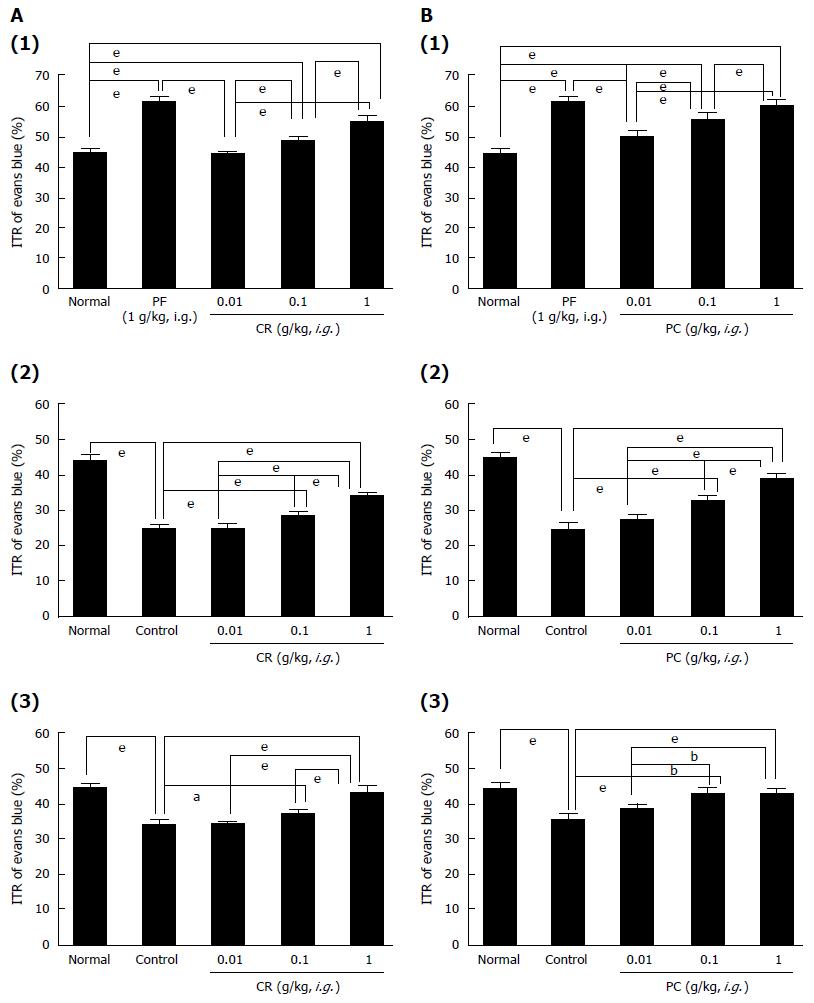Copyright
©The Author(s) 2017.
World J Gastroenterol. Apr 21, 2017; 23(15): 2705-2715
Published online Apr 21, 2017. doi: 10.3748/wjg.v23.i15.2705
Published online Apr 21, 2017. doi: 10.3748/wjg.v23.i15.2705
Figure 1 HPLC chromatograms of standard compounds (A) and extract of Hwangryunhaedok-tang (B) obtained at a UV wavelength of 240 nm.
1, Geniposide; 2, berberine chloride; 3, baicalin; 4, wogonin.
Figure 2 Increasing effect of extract of Hwangryunhaedok-tang on normal gastric emptying and on loperamide- or cisplatin- induced delayed gastric emptying.
A 5-HT4 receptor agonist (mosapride, 5 mg/kg) or a dopamine receptor antagonist (domperidone, 5 mg/kg) was administered in distilled water. A: After a 24 h fast, animals (n = 6/group) were orally dosed with HHTE at the indicated dosages; B: Loperamide-induced gastric emptying (GE) delay was prevented by Lizhong Tang extract; C: Lizhong Tang pretreatment prevented cisplatin-induced GE delay. GE percentages were calculated as described in Materials and Methods. Bars represent mean ± SE. aP < 0.05, eP < 0.001. Significantly different from normal controls. Mosa.: Mosapride; Dom.: Domperidone; p.o.: per os, oral administration; i.p.: Intraperitoneally.
Figure 3 Effects of the four components of extract of Hwangryunhaedok-tang on gastric emptying.
A: 5-HT4 receptor agonist (mosapride, 5 mg/kg) or a dopamine receptor antagonist (domperidone, 5 mg/kg) was administered in distilled water. After a 24 h fast, animals (n = 6/each group) were orally dosed with four components of HHTE, that is, A: Gardeniae Fructus (GF); B: Scutellariae Radix (SR); C: Coptidis Rhizoma (CR); or D: Phellodendri Cortex (PC), at the indicated dosages. GE percentages were calculated as described in Materials and Methods. Bars represent mean ± SE. bP < 0.01, eP < 0.001. Significantly different from normal controls. Mosa.: Mosapride; Dom.: Domperidone.
Figure 4 Effects of extract of Hwangryunhaedok-tang on percent intestinal transit rates in normal mice and in the two gastrointestinal motility disorder mouse models.
A: ITR% values of normal mice pretreated with HHTE prior to Evans Blue administration (n = 15 for each bar); B: ITR% values of acetic acid (AA)-induced mice induced 30 min before the i.g. administration of Evans blue (n = 9 per bar); C: ITR% values of streptozotocin (STZ)-induced mice induced 2 mo before the i.g. administration of Evans Blue (n = 9). Bars represent mean ± SE. aP < 0.05; bP < 0.01; eP < 0.001. Significantly different from normal controls. PF: Poncirus trifoliate Raf; Lope.: Loperamide; GMDl: Gastrointestinal motility disorder; ITR%: Intestinal transit rates.
Figure 5 Effects of Gardeniae Fructus and Scutellariae Radix on percent intestinal transit rates in normal mice and in the two gastrointestinal motility disorder mouse models.
A: ITR% values of (1) normal mice and (2) acetic acid (AA)-induced and (3) streptozotocin (STZ)-induced mice pretreated with GF prior to Evans Blue administration (n = 10 for each bar); B: ITR% values of (1) normal, (2) acetic acid (AA)-induced, and (3) streptozotocin (STZ)-induced mouse models pretreated with SR prior to Evans Blue administration (n = 10). Bars represent mean ± SE. bP < 0.01, eP < 0.001. Significantly different from normal controls. PF: Poncirus trifoliata Raf; GF: Gardeniae Fructus; SR: Scutellariae Radix; GMDl: Gastrointestinal motility disorder; ITR%: Intestinal transit rates.
Figure 6 Effects of Coptidis Rhizoma and Phellodendri Cortex on percent intestinal transit rates in normal mice and in the gastrointestinal motility disorder mouse models.
A: ITR% values of (1) normal mice and (2) acetic acid (AA)-induced and (3) streptozotocin (STZ)-induced mice pretreated with CR prior to Evans Blue administration (n = 10); B: ITR% values of (1) normal mice and (2) acetic acid (AA)-induced and (3) streptozotocin (STZ)-induced mouse models pretreated with PC prior to evans blue administration (n = 9 for each bar). Bars represent mean ± SE. aP < 0.05, bP < 0.01, eP < 0.001. Significantly different from normal controls. PF: Poncirus trifoliata Raf; GF: Gardeniae Fructus; SR: Scutellariae Radix; GMDl: Gastrointestinal motility disorder; ITR%: Intestinal transit rates.
- Citation: Kim H, Kim I, Lee MC, Kim HJ, Lee GS, Kim H, Kim BJ. Effects of Hwangryunhaedok-tang on gastrointestinal motility function in mice. World J Gastroenterol 2017; 23(15): 2705-2715
- URL: https://www.wjgnet.com/1007-9327/full/v23/i15/2705.htm
- DOI: https://dx.doi.org/10.3748/wjg.v23.i15.2705














